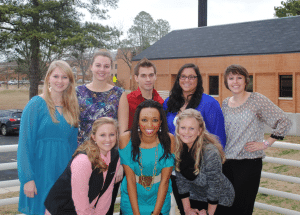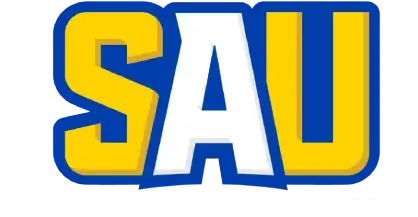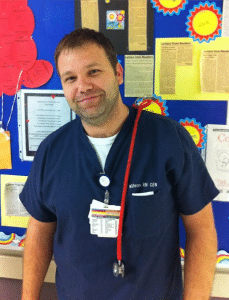Welcome Back From SNA
– Dustin Carter, SNA President
Welcome back everyone! We have a great semester planned. I would first like to thank everyone for their hard work last semester. We accomplished a lot. The Cystic Fibrosis fund-raiser made over $200.00 and the Hurricane Isaac fundraiser made $182.00. We also volunteered over 1,100 hours to numerous organizations like the Hannah Medical Center and Race for the Cure.
As an organization, we have branched out to the Southern Arkansas University campus more than ever before.

2012-2013 Executive Board (front row from left) Jordan McAd-ams, Karrah Clark, Michelle Taylor, (back row from left) Lane Bauman, Ambrosia Caruso, Dustin Carter, Whitley Hill, and Megan Black.
This amazing newsletter was created to inform SAU about what the nursing pro-gram is up to, and what we have accomplished. SNA participated in the 32nd Annual Bed Race winning the Best Presentation Award for our bed’s theme “Code Blue.” This was also the first year for SNA to participate in all of the SAU Homecoming activities, and we won a Mulerider Spirit Award.
The SAU Department of Nursing has definitely made a name for itself, and I am proud to be a part of it.
In closing, I would like to mention a few events to be looking forward to. Be ready for elections in March. I strongly suggest researching the position you wish to run for. Sit down and have a conversation with the officer currently holding the position – we don’t bite!
The Relay for Life committee is in the process of creating our most exciting booth yet for this event. I would definitely suggest looking into participating, not only for a fun time, but also for the wonderful cause it is going towards.
I wish everyone the best of luck this semester.
Nursing Spotlight: Emergency Department
-Kendall Wilson, RN
I graduated with my Associate of Science in Nursing from Southern Arkansas University in 1998 and currently work as the charge nurse of the Emergency Department (ED) at the Medical Center of South Arkansas (MCSA). I chose the Emergency Room be-cause I like a challenge; every hour and every day is different.
I have attended disaster training, which is an area of concern for all hospitals. We do have a disaster team at MCSA and as charge nurse, it is my job to perform a disaster triage by using a color coded system. This does not include just the ED, but it is a collaboration of all the departments.
In the ED, it is my job is to ensure the flow of patients into and out of the department. One of the ways I accomplish this is by having properly trained staff and the right equipment. We use a five level triage system at MCSA. This system ensures that the most critical patients are seen first. After the patient’s level is deter-mined, he or she is as-signed to a primary nurse. This nurse then performs all orders and treatments and also follows the patient until discharge.
Treatment of a trauma patient differs from a general ED patient. For a major trauma patient, several nurses will be assigned with each performing specific duties. However, there is really no typical day in the ED – that’s why I love my job! If you don’t like what you are doing right now, just wait an hour in the ED and it will change.
If you are thinking about a job in the ED, start working on certifications like CEN, ACLS, PALS, TNCC, etc. Most emergency departments require additional training.
Become a nurse for the right reason – not because someone else wants you to be a nurse. If you do this, you will go home and sleep good every night knowing you made a difference in someone’s life.
Campus Safety at SAU
– Megan Black
As future nurses, many of us will participate in disaster preparedness courses at some point in our careers. These classes are designed to train the participant in how to respond to an emergency situation. With the current political arguments over gun control and acts of violence on school campuses, it is evident that now, more than ever, knowing what to do during a disaster situation is of the utmost importance. So, if a disaster, natural or man-made, were to occur at Southern Arkansas University, do you know what to do?
The University Police Department of SAU has an Emergency Operations Plan in place for emergency planning and response. These plans cover numerous situations that could arise in the event of an emergency.
This guide details actions that students, faculty, and staff should take during situations like mass shootings, bomb threats, and severe weather and can be found on the UPD website.
It is important to remember that during a disaster or emergency situation the UPD will provide instruction on the safest action to take. Students, faculty, and staff should also sign up for the Rave Alert system, which sends out notifications via text or email during an emergency situation.
The UPD may be reached at (870)234-4100. Always remember for emergencies, dial 911.
Understanding Complementary and Alternative Therapy
– Janet Johnson Deeds, RN, MSN, MHA
Nursing students and faculty alike are starting to see the term Complementary and Alternative Therapy (CAM) referenced in text books. So what is CAM?
According to the National Institute of Health (2008), CAM is defined as a group of diverse medical and health care systems, practices, and products that are not generally considered part of conventional medicine. In other words, CAM are alternative medical theories and/or practices that incorporate mind-body interventions or biologically based therapies, some that have not yet been scientifically proven.
So much of our teaching and learning principles are based upon traditional or conventional nursing practice; however, nursing professionals should be supportive of people using complementary therapies. Current trends in health care focus on health and wellness and there is an ever increasing popularity of CAM in today’s health care arena. This consumer driven movement toward CAM, along with a more informed health care purchaser has pushed the boundaries of conventional medicine and CAM has become more widely acceptable to health care practitioners.
As the nursing profession learns more on integrating the mainstream medical therapies and CAM, consideration should be given to the safety and effectiveness of such practices. There are many different types of complementary and alternative therapies, including the following: aromatherapy, acupuncture, herbal medication, ayurveda, chiropractic, homeopathy, massage therapy, meditation, naturopathic medicine, osteopathy, special diets, traditional Chinese medicine.
As nursing professionals, we should encourage patients to let the health care providers about any complementary health practices that are being used to help manage their health. Informing the health care provider of these practices will help ensure coordinated and safe care.
Gun Violence: One Nurse’s Story…
– Mary Armwood, MSN, RN-Assistant Professor
“When something happens like the senseless killings in Connecticut, it brings all the memories back for parents who have lost children. My heart aches for the parents of Newtown who lost their babies. How do you make sense of something that makes no sense?
On March 5, 1995, I received the news that no mother wants to hear. My only child had been killed, and the woman who killed him also killed herself. How do you make sense of something that makes no sense?
I can remember the days, weeks, months, and years after Scotty’s murder being dark and gray, no colors. It seemed like I was in a deep hole and there was emptiness in the pit of my belly.
This feeling went on and on and on and I don’t really remember when it left. I just know that one day, the world had color again. The journey from there to here has not been an easy one. Whenever I hear that a parent has lost a child, I always say that I wish I could “fast forward” the parents through the grief, but there is no “fast forward” button in life. You have to feel it, go through it, day by day, minute by minute.
My prayer is that all the parents who lost children at Sandy Hook Elementary School on December 14, 2012, will have, as I did, family, friends, and an abounding faith in our Lord and Savior’s will for our life. We always ask the question “why” when the only person who might know “why” is gone, too.
Gun laws might not have made a difference in my son’s killing because the woman was in the military and had a government-issued weapon. Do I think that oozies and AK 47s should be available for individuals? No. Should we be more vigilant in keeping guns out of the hands of people with mental illness? Yes. Do I think the answer to senseless killing is simple? No, but I think we all need to come together to do more to keep our society, especially our children, safe. It helps me if I don’t dwell on the “why” because how can you make sense of something that makes no sense.”
On the Chart is an e-Newsletter published by the Student Nurses’ Association of Southern Arkansas University. For suggestions or submissions, please contact Megan Black at mlblack9421@muleriders.saumag.edu.

